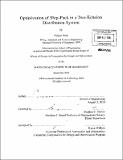| dc.contributor.advisor | Stephen C. Graves. | en_US |
| dc.contributor.author | Wen, Naijun | en_US |
| dc.contributor.other | Massachusetts Institute of Technology. Computation for Design and Optimization Program. | en_US |
| dc.date.accessioned | 2011-03-24T20:24:10Z | |
| dc.date.available | 2011-03-24T20:24:10Z | |
| dc.date.copyright | 2010 | en_US |
| dc.date.issued | 2010 | en_US |
| dc.identifier.uri | http://hdl.handle.net/1721.1/61903 | |
| dc.description | Thesis (S.M.)--Massachusetts Institute of Technology, Computation for Design and Optimization Program, 2010. | en_US |
| dc.description | Cataloged from PDF version of thesis. | en_US |
| dc.description | Includes bibliographical references (p. 61-62). | en_US |
| dc.description.abstract | The traditional Economic Order Quantity (EOQ) model ignores the physical limitations of distribution practices. Very often distribution centers (DC) have to deliver merchandise in manufacturer-specified packages, which can impose restrictions on the application of the economic order quantity. These manufacturer-specified packages, or ship-packs, include cases (e.g., cartons containing 24 or 48 units), inners (packages of 6 or 8 units) and eaches (individual units). For each Stock Keeping Unit (SKU), a retailer decides which of these ship-pack options to use when replenishing its retail stores. Working with a major US retailer, we have developed a cost model to help determine the optimum warehouse ship-pack. Besides recommending the most economical ship-pack, the model is also capable of identifying candidates for warehouse dual-slotting, i.e., two picking modules for the same SKU that carry two different pack sizes. We find that SKUs whose sales volumes vary greatly over time will benefit more from dual-slotting. Finally, we extend our model to investigate the ideal case configuration for a particular SKU, that is, the ideal size for an inner package. | en_US |
| dc.description.statementofresponsibility | by Naijun Wen. | en_US |
| dc.format.extent | 62 p. | en_US |
| dc.language.iso | eng | en_US |
| dc.publisher | Massachusetts Institute of Technology | en_US |
| dc.rights | M.I.T. theses are protected by
copyright. They may be viewed from this source for any purpose, but
reproduction or distribution in any format is prohibited without written
permission. See provided URL for inquiries about permission. | en_US |
| dc.rights.uri | http://dspace.mit.edu/handle/1721.1/7582 | en_US |
| dc.subject | Computation for Design and Optimization Program. | en_US |
| dc.title | Optimization of ship-pack in a two-echelon distribution system | en_US |
| dc.type | Thesis | en_US |
| dc.description.degree | S.M. | en_US |
| dc.contributor.department | Massachusetts Institute of Technology. Computation for Design and Optimization Program | |
| dc.identifier.oclc | 706826069 | en_US |
